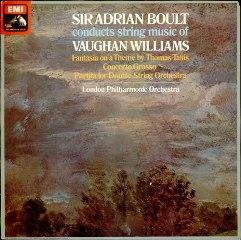Sir Adrian Boult conducts string music of Vaughan Williams (1976)
Sir Adrian Boult conducts string music of Vaughan Williams (1976)

1. Fantasia on a Theme by Thomas Tallis Concerto Grosso : 2. I. Intrada 3. II.Burlesca ostinato 4. III. Saraband 5. IV. Scherzo 6. V. March and Reprise Partita for Double String Orchestra: 7. I. Prelude & II. Scherzo ostinato 8. III. Intermezzo 9. IV. Fantasia Rodney Friend & Russell Gilbert (violins), John Chambers(Viola) & Alexander Cameron (cello) (1) London Philharmonic Orchestra Sir Adrian Boult – conductor
The first performance of Vaughan Williams' Fantasia on a Theme by Thomas Tallis took place at the Three Choirs Festival in Gloucester Cathedral on September 6, 1910. The program was primarily devoted to Sir Edward Elgar's oratorio The Dream of Gerontius, which may partly account for its relatively cool reception. But its treatment, unusual for its day, of the unusual source material may also have puzzled the audience.
Vaughan Williams encountered Tallis' hymn while editing The English Hymnal in 1906; it had first appeared in Archbishop Parker's Metrical Psalter in 1567, set to the words, "Why fumeth in fight?" The peculiar modal qualities of the tune, with its prominent flatted seventh, not only allowed the composer considerable harmonic freedom from the prevailing strictures of diatonicism and chromaticism, but also made possible the simultaneous sense of the ancient and the modern that is the work's hallmark.
The Tallis Fantasia is scored for two string orchestras, one functioning as a "distant" choir, and a solo string quartet. After five widely spaced chords and a few bars in which the theme is fragmentarily mused upon by pizzicato basses, cellos, and swaying middle strings, arco, Tallis' hymn tune is stated in its original harmony by violas and celli with tremolando accompaniment by the high strings, and is then repeated in a setting that exploits all of the harmonic and contrapuntal facilities of a large string section.
The string choirs then separate for a short section in which fragments of Tallis' theme in the first string orchestra are answered by distant chordal musings from the second orchestra. This serves not only as a brief development section but also introduces the solo string quartet, whose masterly counterpoint demonstrates Vaughan Williams' affinity for stringed instruments. As the rhapsodic meditation increases in intensity, the more modern aspects of the composition come into focus, with vaguely impressionistic harmonies mingling with the modal, leading to an impressive climax in which the two orchestras are unleashed in their full chordal power. The string quartet leads a final, luminous musing on Tallis' tune, and the Fantasia ends with a short coda in which the solo violin pronounces a brief benediction as the orchestra falls away. ---Mark Satola, Rovi
Vaughan Williams had a life-long interest in amateur and student music making, and often wrote works with such performers in mind. Such is the case with his Concerto Grosso, which was commissioned for the twenty-first anniversary of the Rural Music Schools Association. The Concerto is written for string orchestra divided into three groups: the concertino, featuring skilled players; the tutti, for players who can manage the third position and some double stops; and an ad lib group of less-skilled players, including those who, in the composer's words, "prefer to use only open strings." Over 400 string players from the Rural Music Schools Association, led by Sir Adrian Boult, took part in the premiere of the Concerto on November 18, 1950. The Queen was present at that concert, and, characteristically, Vaughan Williams chose not to sit in the Royal Box as invited, but sat amongst the second violins "just to see how they are getting on."
Despite its origins in the world of music education, the Concerto Grosso is a work of great ingenuity and tunefulness that should be better known. It opens with a grand, expansive Intrada, followed by a rustic Burlesca ostinata with pizzicato accompaniment and a sweetly flowing contrasting central section. The central third movement is a rich, melancholic, and very lovely Sarabande. A playful Scherzo and a slightly sardonic March and Reprise, which features a return of the music of the opening Intrada, bring the work to a close. --- Chris Morrison, Rovi
In 1938, Vaughan Williams wrote a piece called Double Trio, but shelved it for nearly a decade. After the war, he picked the score of the work back up and decided its music would be better-suited to a larger instrumentation. He fashioned the piece for two string orchestras of disproportionate size, neither featuring second violins. The mood is light throughout and Vaughan Williams avoids using the two string bodies for contrast, choosing instead to alternate their roles, with one playing in the foreground and one in the background. The Partita is comprised of four movements with the first, a Prelude, marked Andante tranquillo. It is a pleasant, thoroughly enjoyable creation whose thematic charm and subtle scoring reveal this multifaceted composer's more genial side while setting the general tone of the work. The second movement is a Scherzo, or as Vaughan Williams calls it here, Scherzo Ostinato. Marked Presto, it is a catchy piece whose menacing elements are really good-natured and colorful, having much the spirit of the Scherzo in the composer's largely serene Symphony No. 5 (completed in 1943). The third movement is an Intermezzo, marked Andante con moto and carrying the subtitle "Homage to Henry Hall." Hall (1898-1989) was a prominent British band conductor who for years led the BBC Dance Orchestra. The Intermezzo's main theme is haunting and somewhat nocturnal, and even though it nearly turns funereal, its music remains light and subtly colorful. The finale, "Fantasia," is marked Allegro and is lively and brilliant in its scoring with rhythmic aspects that are imaginatively developed. The Partita lasts around 20 minutes in a typical performance and should have wide appeal, especially to fanciers of music for string ensembles. ---Robert Cummings, Rovi
download: uploaded yandex 4shared mediafire solidfiles mega zalivalka filecloudio anonfiles oboom
Zmieniony (Czwartek, 12 Czerwiec 2014 14:13)








